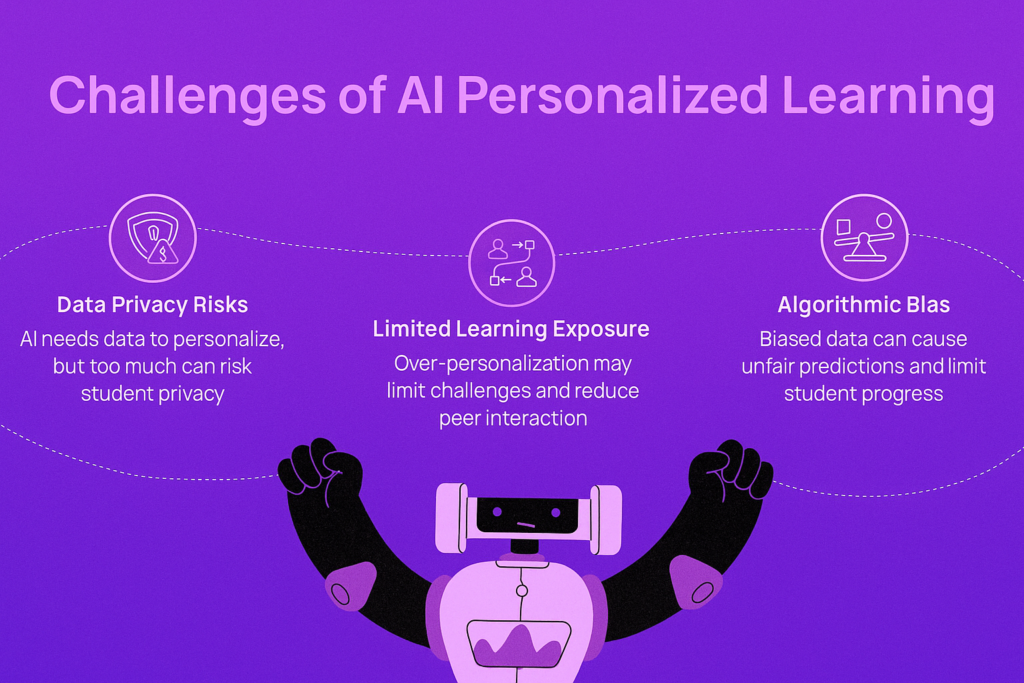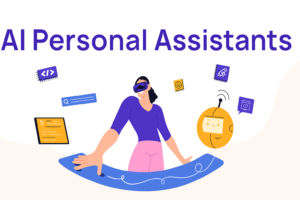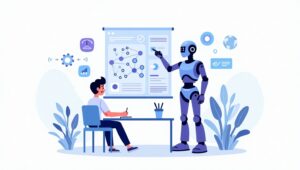click to get service View profile
In today’s rapidly evolving digital world, artificial intelligence is transforming both teaching and learning like never before. Traditional education systems, often built on a one-size-fits-all model, are being replaced by smarter, more tailored approaches. With AI Personalize Learning, educators can now adapt content to match each student’s individual pace, preferences, and performance. From intelligent tutoring systems to real-time analytics and feedback, AI enables more engaging, effective, and student-centered education. This shift is not only improving learning outcomes but also redefining how educational institutions operate across the globe. In this article, we dive into the power of AI personalized learning and its role in shaping the future of education.
8 AI Approaches That Enable Personalized Learning
AI is already playing a powerful role in making education more personalized and effective. From adaptive learning platforms to intelligent feedback tools, these real-world applications highlight how AI Personalize Learning is actively transforming classrooms and enhancing the overall learning experience for students.

From virtual tutors to automated feedback systems, these solutions form the core of many AI personalized learning plans and help educators adapt to each learner’s progress.
1. Chatbots
Educational chatbots act as always-available learning assistants, helping students navigate content and answer questions anytime they need support. Powered by natural language processing (NLP), these chatbots understand student queries and respond with relevant explanations, resource links, or follow-up prompts to encourage deeper understanding. As a key component of AI personalized learning, they provide tailored support that adapts to each learner’s unique needs and pace.
Example: Duolingo’s chatbot helps people practice conversations in a fun, low-pressure way. For example, if someone types “I want to learn how to order food in Spanish,” the chatbot creates a short role-play and teaches useful words and phrases. It also adjusts the help it gives based on how the learner responds.
1. Adaptive Learning
Adaptive learning is an AI-powered educational approach that adjusts educational content in real time based on each student’s performance and behavior. It monitors user interactions, such as quiz scores or time spent on questions, to detect areas of strength or struggle. Based on this data, the system adapts the difficulty of the content or provides additional resources like video explanations or simplified concepts.
Example: DreamBox Learning, a math platform for K–8 students, continuously collects data from every click and decision a student makes. If a student struggles with a concept like fractions, DreamBox automatically adjusts the lesson path to provide visual supports or foundational reviews before continuing.
2. Multimodal Learning
Multimodal learning is an AI-driven approach that presents educational content in various formats such as text, video, audio, and interactive simulations. In digital classrooms and online platforms, learners can choose the format that suits their preferences and learning styles. By offering this level of flexibility, AI personalized learning ensures that students absorb information in the most effective way for them, boosting both engagement and retention.
Example: Coursera offers video lectures, readings, quizzes, and discussion prompts all in one course. Given that, learners can watch a lecture, read a supporting article, take a short quiz, and then join a forum discussion, choosing the format that best fits their learning style.
3. Individualized Learning Paths
Individualized learning paths are AI-generated study plans tailored to each learner’s goals, interests, and learning history. As learners learn, the system adjusts what they see next, keeping content relevant and personalized. These paths are built into many online learning platforms, helping learners stay on track and progress at their own pace.
Example: LinkedIn Learning creates personalized learning paths by recommending courses based on a learner’s professional goals, skills, and past activity. For example, an adult learner aiming for a career in digital marketing might be guided through a tailored path starting with basic SEO. After that, moving to content strategy and analytics, adapting as they complete lessons or show mastery.
4. Personalized Assessment and Feedback
Personalized assessment and feedback is a powerful element of AI Personalize Learning, designed to create customized tests and exercises that match each student’s skill level. As students work through assignments, the AI continuously adapts the difficulty and delivers instant, insightful feedback. This responsive approach not only helps learners identify and understand their mistakes but also accelerates their progress by offering targeted guidance tailored to their individual needs.
Example: Google Classroom’s adaptive quizzes use AI to assess student answers and provide feedback like “Try reviewing the order of operations” if the student answers a math question incorrectly. Over time, the quiz adjusts difficulty or question types based on the student’s improvement.
5. Personalized Recommendations
AI-powered recommendation systems in education suggest learning resources, such as readings, exercises, or videos, based on a learner’s activity history and preferences. These systems use data such as previously completed modules, content ratings, and engagement time to generate relevant suggestions.
Example: Khan Academy follows how a learner is doing in different subjects and suggests videos or practice exercises where they need extra help. For example, if a learner struggles with algebra, the system might recommend going back to easier topics like basic equations or simple math, so they can build a stronger foundation before moving forward.
6. Intelligent Tutoring Systems
Intelligent tutoring systems are AI-driven tools that replicate the benefits of one-on-one tutoring by adapting to each student’s individual learning journey. These systems provide step-by-step guidance, ask thoughtful follow-up questions, and present concepts in multiple ways based on the learner’s responses. Often used in subjects like math and science, they play a crucial role in AI Personalize Learning by offering structured, personalized instruction that helps students grasp complex topics more effectively.
Example: AutoTutor, developed for college students, uses natural language understanding to engage learners in conversation-based learning. When a student gives a partially correct answer in a physics question, AutoTutor prompts them with guiding questions or rephrases content to clarify misunderstandings, mimicking how a human tutor would interact.
7. Predictive Analytics
AI personalize learning leverages both historical and real-time data to predict student outcomes and identify learners who may be at risk of falling behind. Through predictive models, it analyzes patterns like missed assignments, low quiz scores, or reduced engagement with the platform, enabling timely alerts for educators and triggering early interventions to support student success.
Example: Georgia State University utilizes predictive analytics to track over 800 variables per student, including attendance and GPA trends. The system alerts advisors if a student shows signs of academic trouble, allowing staff to intervene quickly with personalized support like tutoring or advising.
Benefits of AI Personalized Learning
AI is revolutionizing education by making learning not only more accessible but also more effective for every student. Through AI Personalize Learning, educators can now identify and meet individual learning needs at scale—something that was difficult to achieve in traditional classroom settings. These intelligent systems empower teachers to deliver targeted support, helping each student thrive based on their unique pace and progress.

Below are some of the most impactful advantages:
Improved Learning Outcomes
When students engage with lessons tailored to their individual level, pace, and learning style, they’re more likely to grasp and retain the material effectively. Through AI Personalize Learning, the system dynamically adjusts the complexity and delivery of each topic to ensure no student is left behind or slowed down. This approach leads to improved test scores, deeper understanding, and stronger long-term academic success.
Increased Engagement and Retention
Engagement rises when learners feel connected to what they’re learning. AI can adjust content to match interests, make lessons interactive, and add game-like elements such as points, levels, or badges. These features make learning more fun and help learners stay focused and remember information better.
Scalability for Educational Institutions
Before the advent of AI, personalized learning was mostly limited to one-on-one tutoring or small group sessions, making it difficult to scale. Today, AI Personalize Learning enables educators to deliver customized learning experiences to thousands of students at once. These intelligent systems create individualized learning paths without adding to teachers’ workloads or requiring additional staff, making high-quality, student-centered instruction more accessible than ever.
Better Insights for Educators
AI tools continuously collect data on how learners interact with materials, where they succeed, and where they struggle. This data is turned into visual dashboards that help educators spot learning gaps, track class-wide trends, and make timely adjustments to their teaching strategies. It shifts decision-making from assumptions to evidence-based actions.
Challenges of AI Personalized Education

While AI opens up powerful new opportunities in education, it also presents critical challenges that institutions must thoughtfully navigate. From data privacy concerns to algorithmic bias, understanding these risks is essential for implementing AI Personalize Learning in a responsible and ethical way—ensuring it truly benefits every learner.
Data Privacy Risks
AI systems need a lot of learner data to personalize lessons, things like quiz scores, learning speed, or time spent on a topic. If this data is missing, incorrect, or limited, the AI may suggest the wrong content or misunderstand a learner’s needs. On the other hand, collecting too much data raises serious privacy concerns. Schools and platforms must balance personalization with learner privacy, making sure data is protected and only used for the right reasons.
Limited Learning Exposure
While it’s helpful when AI suggests content tailored to the student, too much personalization can be a problem. If the AI only shows content it thinks the student will succeed with, the student might never be challenged or exposed to new ideas. It can also reduce interaction with peers, making learning feel lonely or repetitive, especially in self-paced online platforms.
Algorithmic Bias
AI systems rely on large volumes of student data to function effectively. However, if this data includes hidden biases—such as lower performance from students in under-resourced schools—the system may produce unfair outcomes. In the context of AI Personalize Learning, this can lead to inaccurate predictions about a student’s potential, possibly restricting access to advanced content or opportunities based on background or early performance, rather than actual ability.
The Future of AI in Personalized Learning
AI personalize learning is rapidly advancing, evolving from tools that simply respond to student performance to intelligent systems that anticipate and proactively support learners. Modern platforms already incorporate adaptive learning, intelligent tutoring, and predictive analytics to customize education in real time. However, the next generation of AI personalize learning is shifting from reactive assistance to proactive engagement, pushing the boundaries of personalization to create even more effective and tailored learning experiences.
Here’s how AI is evolving into a more hands-on, learner-aware role:
- Agentic AI: These AI systems can act independently to support learning. For instance, if a learner hasn’t logged in or completed recent work, the AI can suggest review tasks, send reminders, or adjust the upcoming lesson, without needing a teacher’s prompt.
- Generative AI & Large Language Models (LLMs): These tools can create personalized summaries, quizzes, and explanations in real time. They also understand learners’ natural-language questions and respond in clear, friendly tones, making learning more human-like and accessible across formats or languages.
- Predictive AI: Earlier predictive tools flagged struggling learners after they performed poorly. Now, improved systems can predict challenges before they happen, adjusting content early or alerting teachers so they can intervene before gaps grow.
Together, these innovations point to a future where learning systems are not only smart but also deeply supportive. With responsible AI integration, AI in education is moving from simply automating tasks to actively supporting each learner, making education more personalized, engaging, and effective for everyone.
Final Thoughts
AI personalize learning is more than just a technological trend—it’s a powerful shift in how we deliver education. By customizing lessons, feedback, and learning pace to fit each student’s individual needs, AI personalize learning enables students to achieve better outcomes while helping educators teach more effectively at scale. Although there are important concerns to address, such as data privacy and algorithmic bias, the potential to create more flexible, inclusive, and responsive learning environments is significant. As technology advances, adopting AI personalize learning in a thoughtful and responsible way will be essential to building a smarter and more equitable educational future.

